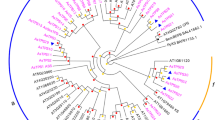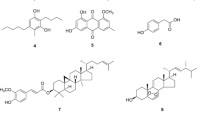Abstract
The resinous portions of Aquilaria and Gyrinops plants are known as ‘agarwood’ and have a distinctive fragrance. To examine the biosynthesis of these fragrant compounds, we previously established cell cultures of Aquilaria crassna in which the production of three sesquiterpenes (α-guaiene, α-humulene, and δ-guaiene) could be induced by methyl jasmonate (MJ), and showed that cloned δ-guaiene synthase from MJ-treated cells is involved in the synthesis of these three compounds, although only very small amounts of α-humulene are produced. In the present study, cDNAs encoding α-humulene synthases were also isolated. Three putative sesquiterpene synthase clones (AcHS1–3) isolated from the MJ-treated cells had very similar amino acid sequences and shared 52 % identity with δ-guaiene synthases. The recombinant enzymes catalyzed the formation of α-humulene as a major product. Expression of transcripts of the α-humulene synthase and δ-guaiene synthase genes in cultured cells increased after treatment with MJ. These results revealed that these α-humulene and δ-guaiene synthases are involved in the synthesis of three sesquiterpenes induced by MJ treatment.




Similar content being viewed by others
References
Ito M, Honda G (2008) Agarwood-its sedative effect on mice and current state in the production sites. Aroma Research 34:122–127
Varma KR, Maheshwari ML, Bhattacharyya SC (1963) The constitution of agarospirol, a sesquiterpenoid with a new skeleton. Tetrahedron 21:1079–1090
Nakanishi T, Yamagata E, Yoneda K, Miura I (1981) Jinkohol, a prezizane sesquiterpene alcohol from agarwood. Phytochemistry 20:1597–1599
Hashimoto K, Nakahara S, Inoue T, Sumida Y, Takahashi M, Masada Y (1985) A new chromone from agarwood and pyrolysis products of chromone derivatives. Chem Pharm Bull 33:5088–5091
Ishihara M, Tsuneya T, Uneyama K (1993) Fragrant sesquiterpenes from agarwood. Phytochemistry 33:1147–1155
Yagura T, Ito M, Kiuchi F, Honda G, Shimada Y (2003) Four new 2-(2-phenylethyl) chromone derivatives from withered wood of Aquilaria sinensis. Chem Pharm Bull 51:560–564
Okugawa H, Ueda R, Matsumoto K, Kawanishi K, Kato A (1996) Effect of jinko-eremol and agarospirol from agarwood on the central nervous system in mice. Planta Med 62:2–6
Okugawa H, Ueda R, Matsumoto K, Kawanishi K, Kato K (2000) Effects of sesquiterpenoids from “Oriental incenses” on acetic acid-induced writhing and D2 and 5-HT2A receptors in rat brain. Phytomedicine 7:417–422
Takemoto H, Ito M, Shiraki T, Yagura T, Honda G (2008) Sedative effects of vapor inhalation of agarwood oil and spikenard extract and identification of their active components. J Nat Med 62:41–46
Ito M, Okimoto K, Yagura T, Honda G (2005) Induction of sesquiterpenoid production by methyl jasmonate in Aquilaria sinensis cell suspension culture. J Essent Oil Res 17:175–180
Okudera Y, Ito M (2009) Production of agarwood fragrant constituents in Aquilaria calli and cell suspension cultures. Plant Biotech 26:307–315
Kumeta Y, Ito M (2010) Characterization of δ-guaiene synthases from cultured cells of Aquilaria, responsible for the formation of the sesquiterpenes in agarwood. Plant Physiol 154:1998–2007
Jones CG, Keeling CI, Ghisalberti EL, Barbour EL, Plummer JA, Bohlmann J (2008) Isolation of cDNAs and functional characterisation of two multi-product terpene synthase enzymes from sandalwood, Santalum album L. Arch Biochem Biophys 477:112–130
Lücker J, Bowen P, Bohlmann J (2004) Vitis vinifera terpenoid cyclases: functional identification of two sesquiterpene synthase cDNAs encoding (+)-valencene synthase and (−)-germacrene D synthase and expression of mono- and sesquiterpene synthses in grapevine flowers and berries. Phytochemistry 65:2649–2659
Arimura G, Huber DPW, Bohlmann J (2004) Forest tent caterpillars (Malacosoma disstria) induce local and systemic diurnal emissions of terpenoid volatiles in hybrid poplar (Populus trichocarpa × deltoides): cDNA cloning, functional characterization, and patterns of gene expression of (−)-germacrene D synthase, PtdTPS1. Plant J 37:603–616
Davis EM, Tsuji J, Davis GD, Pierce ML, Essenberg M (1996) Purification of (+) -delta-cadinene synthase, a sesquiterpene cyclase from bacteria-inoculated cotton foliar tissue. Phytochemistry 41:1047–1055
Cai Y, Jia JW, Crock J, Lin ZX, Chen XY, Croteau R (2002) A cDNA clone for β-caryophyllene synthase from Artemisia annua. Phytochemistry 61:523–529
Bohlmann J, Meyer-Gauen G, Croteau R (1998) Plant terpenoid synthases: molecular biology and phylogenetic analysis. Proc Natl Acad Sci USA 95:4126–4133
Starks CM, Back KW, Chappell J, Noel JP (1997) Structural basis for cyclic terpene biosynthesis by tobacco 5-epi-aristolochene synthase. Science 277:1815–1820
Whittington DA, Wise ML, Urbansky M, Coates RM, Croteau RB, Christianson DW (2002) Bornyl diphosphate synthase: structure and strategy for carbocation manipulation by a terpenoid cyclase. Proc Natl Acad Sci USA 99:15375–15380
Cane DE (1999) Sesquiterpene biosynthesis: cyclization mechanisms. Comprehensive Natural Products Chemistry: Isoprenoids Including Carotenoids and Steroids, vol 2. Pergamon, Oxford, pp 155–200
Kumeta Y, Ito M (2010) Genomic organization of δ-guaiene synthase genes in Aquilaria crassna and its possible use for the identification of Aquilaria species. J Nat Med 65:508–513
Yu F, Okamoto S, Nakasone K, Adachi K, Matsuda S, Harada H, Misawa N, Utsumi R (2008) Molecular cloning and functional characterization of α-humulene synthase, a possible key enzyme of zerumbone biosynthesis in shampoo ginger (Zingiber zerumbet Smith). Planta 227:1291–1299
Keeling CI, Weisshaar S, Ralph SG, Jancsik S, Hamberger B, Dullat HK, Bohlmann J (2011) Transcriptome mining, functional characterization, and phylogeny of a large terpene synthase gene family in spruce (Picea spp.). BMC Plant Biol 11:43–241
Schnee C, Köllner TG, Gershenzon J, Degenhardt J (2002) The maize gene terpene synthase 1 encodes a sesquiterpene synthase catalyzing the formation of (E)-β-farnesene, (E)-nerolidol, and (E, E)-farnesol after herbivore damage. Plant Physiol 130:2049–2060
Yahyaa M, Tholl D, Cormier G, Jensen R, Simon PW, Ibdah M (2015) Identification and characterization of terpene synthases potentially involved in the formation of volatile terpenes in carrot (Daucus carota L.) roots. J Agric Food Chem 63:4870–4878
Acknowledgments
We thank Ms. Kaori Nakano for her technical help in cloning α-humulene synthases. This work was partially supported by the Takeda Science foundation (funds to M. Ito).
Author information
Authors and Affiliations
Corresponding author
Rights and permissions
About this article
Cite this article
Kumeta, Y., Ito, M. Characterization of α-humulene synthases responsible for the production of sesquiterpenes induced by methyl jasmonate in Aquilaria cell culture. J Nat Med 70, 452–459 (2016). https://doi.org/10.1007/s11418-016-0999-8
Received:
Accepted:
Published:
Issue Date:
DOI: https://doi.org/10.1007/s11418-016-0999-8




